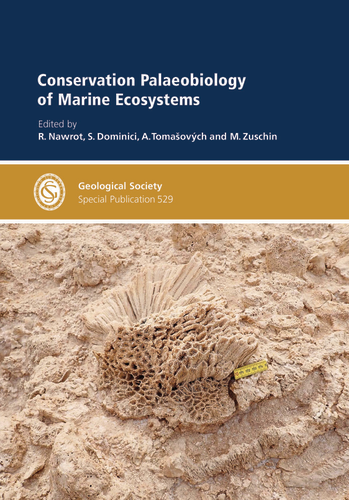Basic research
ŽATKOVÁ, Lucia – MILOVSKÝ, Rastislav** – BECHTEL, Achim – STAREK, Dušan – KYŠKA-PIPÍK, Radovan – ŠURKA, Juraj. n-Alkane and terpenoid fingerprints of modern biomass producers unveil floral changes recorded in postglacial alpine lake sediments, Tatra Mountains, Slovakia. In Organic geochemistry, 2023, vol. 184, art. no. 104672. (2022: 3 – IF, Q2 – JCR, 1.395 – SJR, Q1 – SJR). ISSN 0146-6380. https://doi.org/10.1016/j.orggeochem.2023.104672
Environmental changes in the postglacial period were studied by biomarkers in sediments of two alpine lakes in High Tatra Mts., Slovakia (Trojrohé and Batizovské pleso). We used an actualistic approach and interpreted sedimentary lipid distributions using chemical fingerprints of modern plant groups. Identified chemostratigraphic units roughly conform to boundaries and environmental changes of Holocene paleoclimatic intervals. Diploptene as a biomarker for bacterial activity points to the development of soil cover at the end of the B/A interstadial corresponding to the period of deglaciation of the valley. The absence of conifer biomarkers in Batizovské lake sediments suggests that the upper limit of the continuous Pinus mugo zone never reached 1880 m a.s.l. The dry climate in Younger Dryas was recorded by the Sphagnum retreat. A sharp spike in the abundance of the aromatic terpenoid retene suggested a pluvial episode around 5,000 BP.
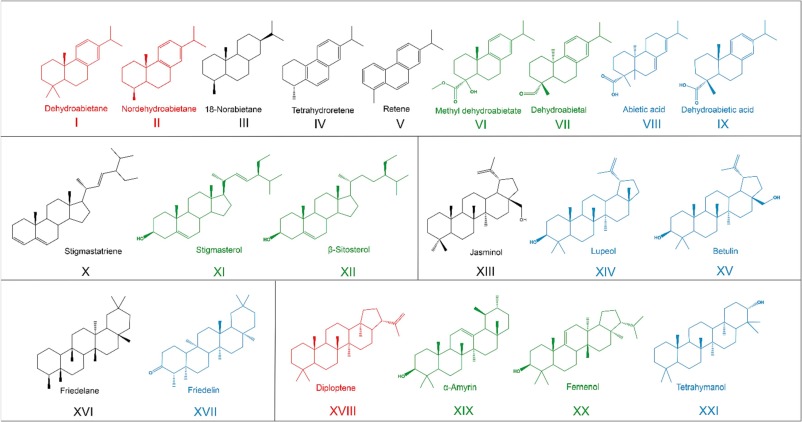
ŠTEVKO, Martin** – MIKUŠ, Tomáš – SEJKORA, J. – PLÁŠIL, Jakub – MAKOVICKÝ, Emil – VLASÁČ, Jozef – KASATKIN, Anatoly. Argentopolybasite, Ag16Sb2S11, a new member of the polybasite group. In Mineralogical Magazine, 2023, vol. 87, no. 3, p. 382-395. (2022: 2.7 – IF, Q2 – JCR, 0.79 – SJR, Q2 – SJR). ISSN 0026-461X. https://doi.org/10.1180/mgm.2022.141
Argentopolybasite is a new member of the polabysite group ant the firdt fully defined mineral in this group without presence of copper in thr crystal structure. Copper was previously considerted as one of the essential elements, without which this type of crystal structure simply cannot be stable in nature at all. The discovery of argentopolybasite completely disproved this assumption- The type locality of argentopolybasite is the Kremnica epithermal Au-Ag deposit. Argentopolybasite is a 25th new mineral deswcribed from the teritory of the Slovak Republic.
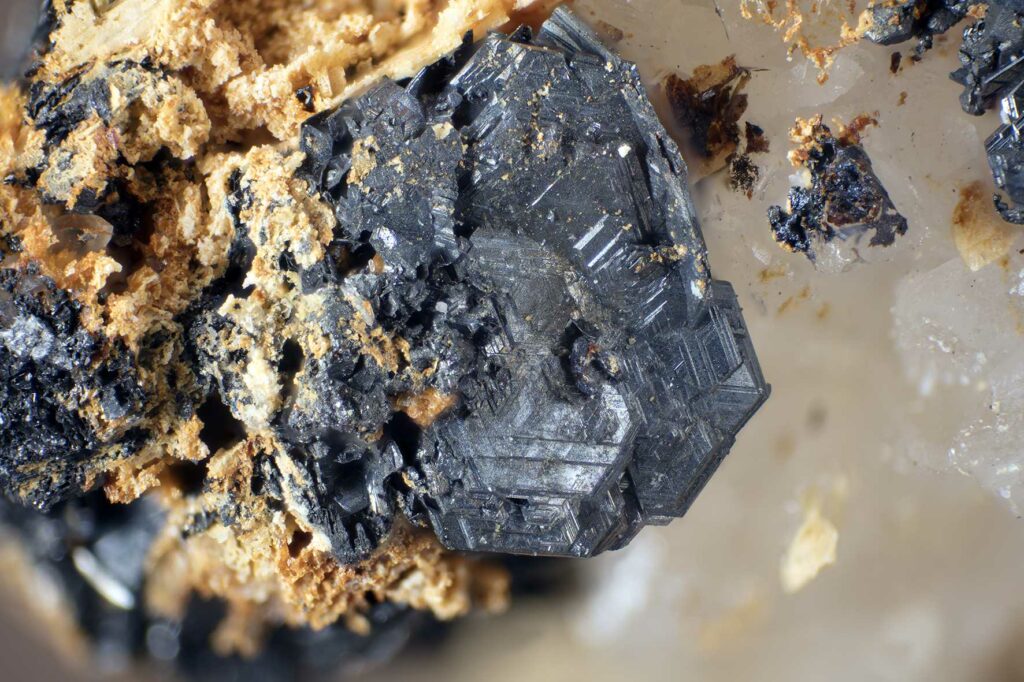
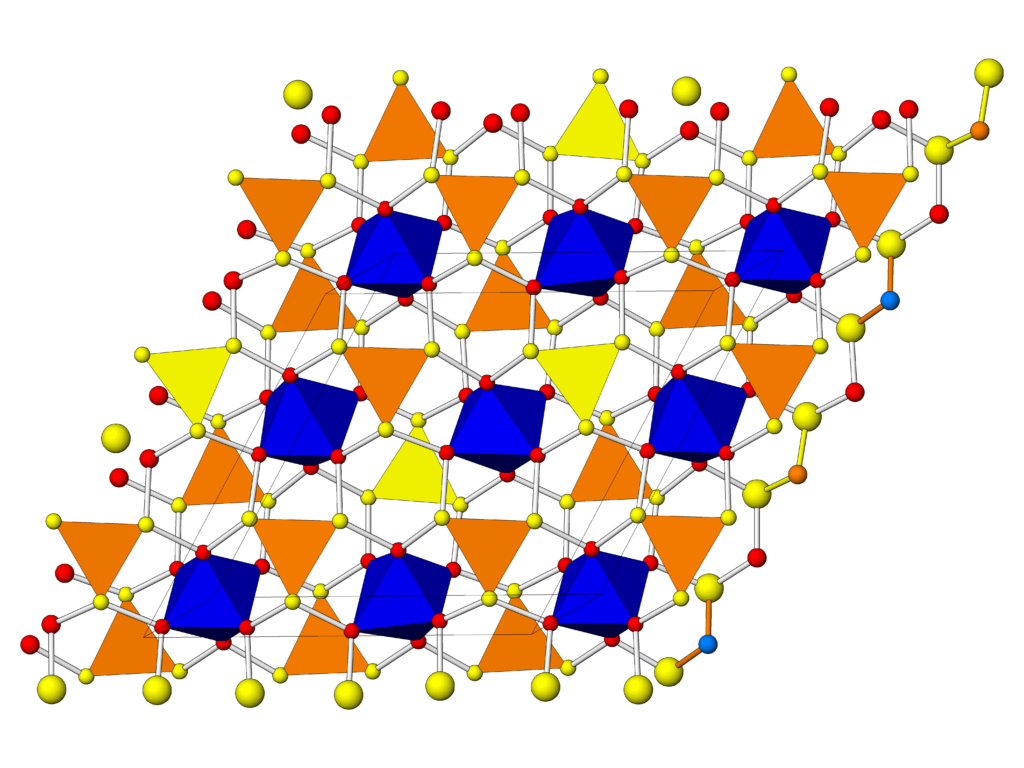
RYBÁR, S.** – KOTULOVÁ, Júlia. Petroleum play types and source rocks in the Pannonian basin, insight from the Slovak part of the Danube Basin. In Marine and Petroleum Geology, 2023, vol. 149, art. no. 106092. (2022: 4.2 – IF, Q1 – JCR, 1.513 – SJR, Q1 – SJR). ISSN 0264-8172. https://doi.org/10.1016/j.marpetgeo.2022.106092
The Danube Basin represents a Miocene depocenter located on the NW margin of the Alpine-Pannonian- Carpathian region and is considered a part of the Pannonian Basin System. The gradual opening of the northern Slovak part of the basin during a 4-stage rifting event between the Badenian, Sarmatian (Langhian, Serravallian) to Pannonian (Tortonian) time reflected not only on the sedimentary fill and the development of volcanic fields but also on individual elements of the petroleum system. The presence of effective petroleum systems is supported by several gas and condensate deposits together with abundant hydrocarbon shows. The study offers new insight into the petroleum plays in the Danube Basin based on new and vintage reflection seismic lines and organic geochemistry data. The contribution of the study is also in the explanation of the origin and distribution of non-hydrocarbon gases (CO2 and N2) in particular sub-basins, which represent a significant risk in the exploration of gas deposits in the Danube basin.
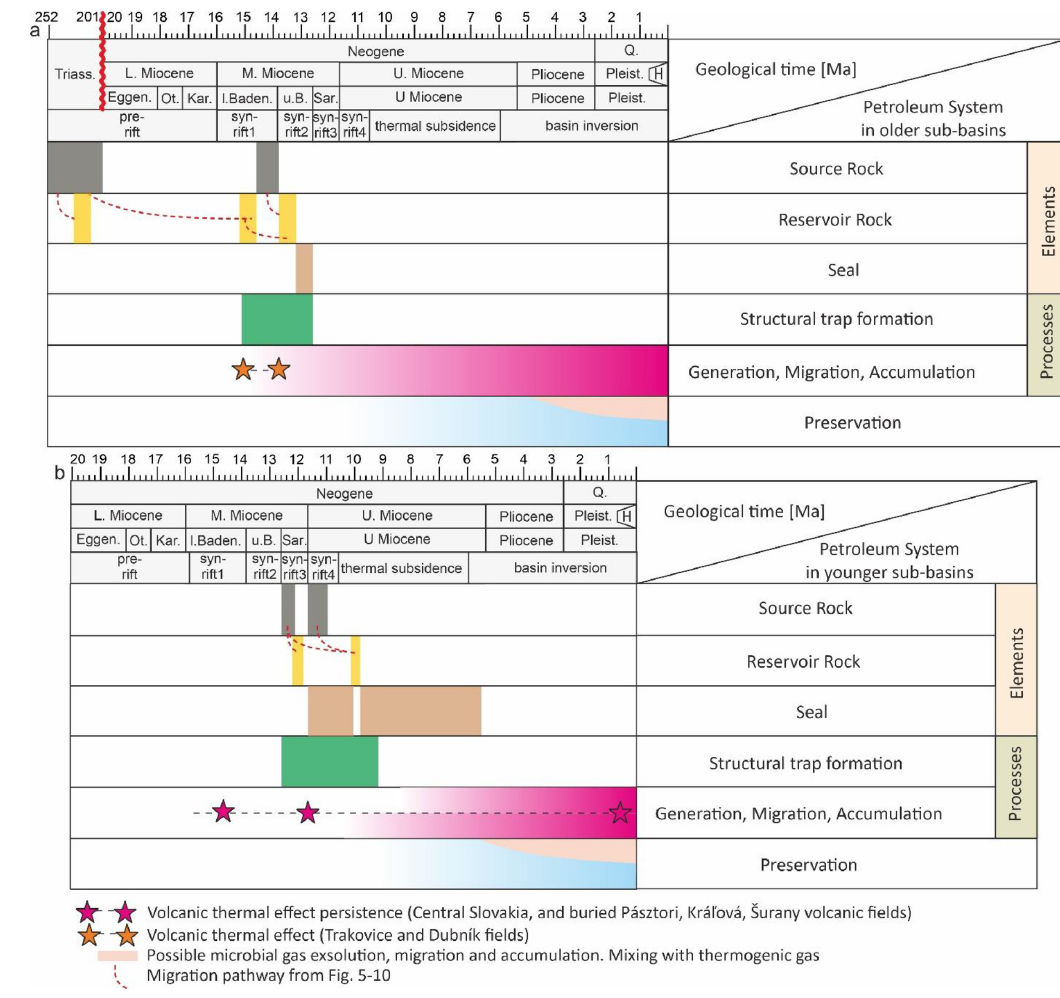
APPLIED RESEARCH
BÓDI, Jozef – VAJDA, Peter** – CAMACHO, Antonio G. – PAPČO, Juraj – FERNÁNDEZ, José María. On gravimetric detection of thin elongated sources using the growth inversion approach. In Surveys in Geophysics, 2023, vol. 44, no. 6, p.1811-1835. (2022: 4.6 – IF, Q1 – JCR, 1.681 – SJR, Q1 – SJR). ISSN 0169-3298. https://doi.org/10.1007/s10712-023-09790-z
Thin elongated sources, such as dykes, sills, chimneys, inclined sheets, etc., often encountered in volcano gravimetric studies, pose great challenges to gravity inversion methods based on model exploration and growing sources bodies. We analysed how the Growth inversion can cope with such sources. We used synthetic spatiotemporal gravity changes caused by simulated sources placed in three real volcanic settings. Our case studies demonstrated the benefits and limitations of the Growth inversion as applied to sparse and noisy gravity change data generated by thin elongated sources.
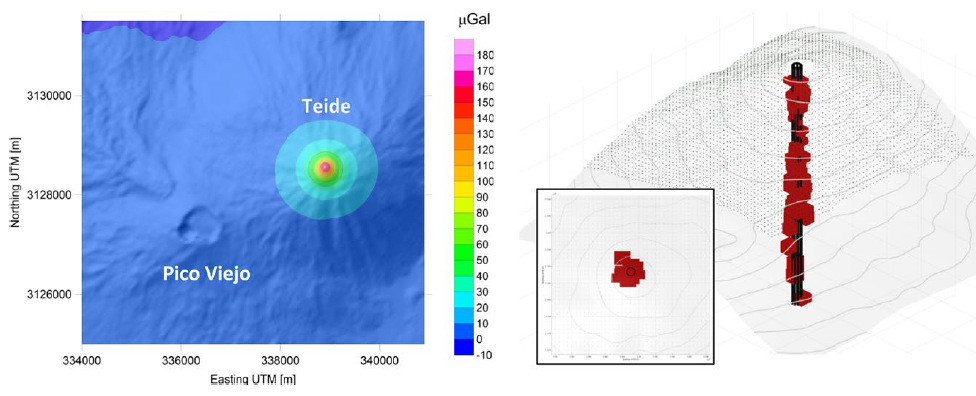
BEZÁK, Vladimír** – BIELIK, Miroslav – MARKO, František – ZAHOREC, Pavol – PAŠTEKA, Roman – VOZÁR, Ján – PAPČO, Juraj. Geological and tectonic interpretation of the new Bouguer gravity anomaly map of Slovakia. In Geologica Carpathica, 2023, vol. 74, no. 2, p. 109-122. (2022: 1.3 – IF, Q4 – JCR, 0.484 – SJR) ISSN 1335-0552. https://doi.org/10.31577/GeolCarp.2023.08
This paper analyzes the latest complete Bouguer gravity anomaly map of Slovakia in relation to the geological structure. The most remarkable regional feature is the large field with low-density masses in the northern part of Central Slovakia (the so-called gravity low), which source are the sediments of the flysch units in the North, and a crust with prevailing granites and orthogneisses in southern part. This field is only the torso of the original one, because in the youngest stages of tectonic development, the originally negative gravity anomalous field in the territory of West and East Slovakia changed to a positive one due to the thinning of the crust and lithosphere by the influence of asthenolithic masses from the mantle. Several local anomalies, mostly areas with strikingly heavier crust were analysed. Prominent horizontal gravity gradients reflect the tectonic interfaces (faults, shear zones) that originated dominantly during the youngest Neoalpine period of tectonic development mainly during the transpressional and extensional stage.
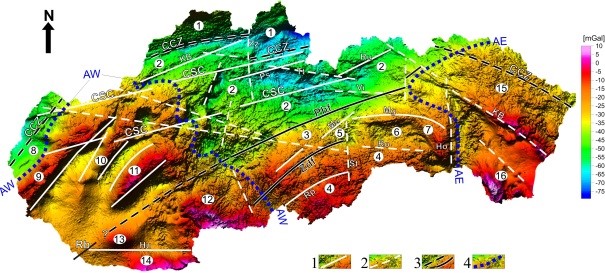
LUKASOVÁ, Veronika** – BUCHHOLCEROVÁ, Anna – ONDERKA, Milan – BIČÁROVÁ, Svetlana – BILČÍK, Dušan – NEJEDLÍK, Pavol. How can the transition from conventional to automatic measurements affect the climatological normals? – A case study from an alpine meteorological observatory at Skalnaté Pleso, Slovakia. In Meteorologische Zeitschrift, 2023, vol. 32, issue 5, p. 431-444 (2022: 1.2 – IF, Q4 – JCR, 0.517 – SJR, Q3 – SJR). ISSN 0941-2948. https://doi.org/10.1127/metz/2023/1200
In climatology, the transition from conventional (manual) to automatic measurement methods is associated with the problem of maintaining the homogeneity of long-term data series. At the Skalnaté Pleso Observatory (1778 m a. s. l., High Tatras), manual meteorological measurements have been carried out since 1943 using the same methods and devices and at the same place. In 2014, the automatic Physicus system with the parallel recording of meteorological data was installed at the observatory.
The aim of our study was to analyse differences between principal climatological parameters from parallel manual and automatic measurements over six years (2017–2022) and propose correction methods. To correct monthly and yearly values of principal climatological parameters derived from automatic measurements, we applied monthly regressions and cumulative distribution functions. Our results showed that, after applying appropriate correction methods, automatic meteorological stations can maintain measurement continuity and homogeneity for interpreting long-term climate trends using monthly and yearly values. However, we recommend a longer period of parallel measurements to validate the correction algorithms and verify the reliability of the automatic measurement system.
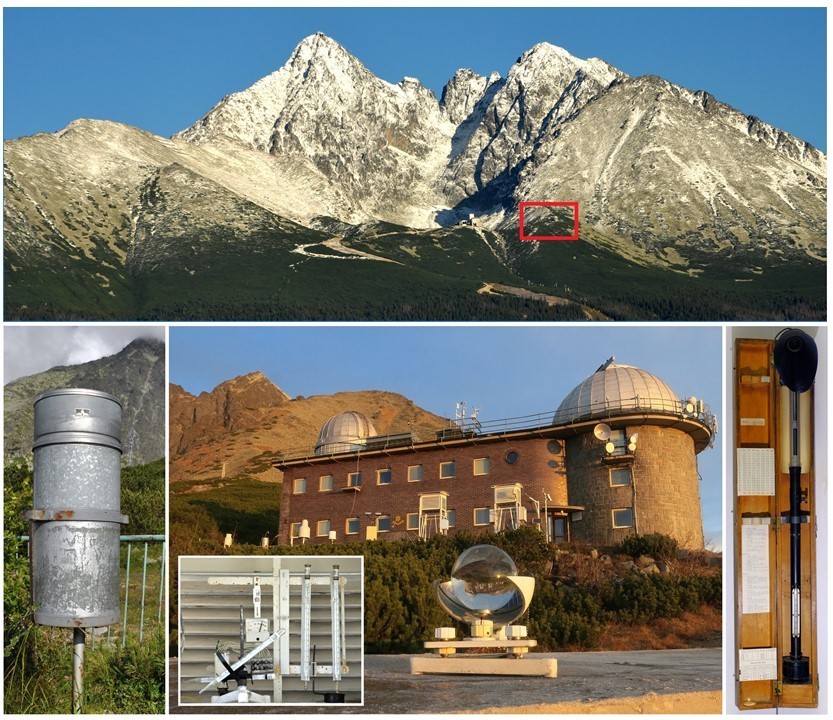
RESEARCH RELATED TO INTERNATIONAL COLLABORATION
MARASZEWSKA, Maria – MAJKA, Jarosław** – HARLOV, Daniel – MANECKI, Maciej – SCHNEIDER, David A. – BROSKA, Igor – MYHRE, Per-Inge. Multi-stage metamorphic and metasomatic imprints on apatite-monazite-xenotime assemblages in a set of small iron oxide-apatite (IOA) ore bodies, Prins Karls Forland, Svalbard. In Ore Geology Reviews, 2023, vol. 155, art. no. 105344. (2022: 3.3 – IF, Q1 – JCR, 1.172 – SJR, Q1 – SJR). ISSN 0169-1368. https://doi.org/10.1016/j.oregeorev.2023.105344
Metasomatism is a fascinating physico-chemical process of the interaction of rocks and minerals with reactive hydrothermal fluids, which are able not only fundamentally change the composition of minerals and rocks, but also form new mineral ore phases. Currently, one of the main sources of rare earth elements in the Europe is the Swedish apatite-iron deposit in Kiruna. Our study was carried out on the still not well explored island of Prins Karls Forland in Svalbard, where during the expedition Maria Maraszewska found a new deposit of the Kiruna type ores. In mineralogical-geochemical research, two associations of minerals were distinguished: (1) fluorapatite and monazite with a low Th content, and (2) fluor-chlorapatite and monazite with a high content of Th. The first case is a metasomatic transformations during overprinting metamorphosis and deformation resulted in release of rare earth elements from host rocks. The second metasomatic stage of transformation formed in the most deformed parts of rocks (shear zones) a new association of monazite with a high content of Th and apatite enriched in elements of Cl, Sr, Mn from close gabroes, rocks from mantle of the Earth. was formed. In conclusion, in the newly discovered apatite-iron rupture of the Kiruna type on Prins Karls island, ore-forming metasomatic transformations were caused by circulating fluids from different sources at different geological events and took place in two stages.
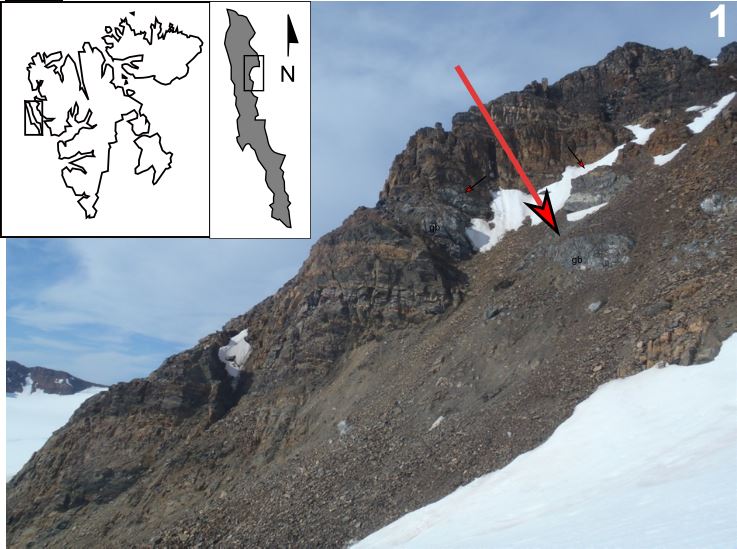
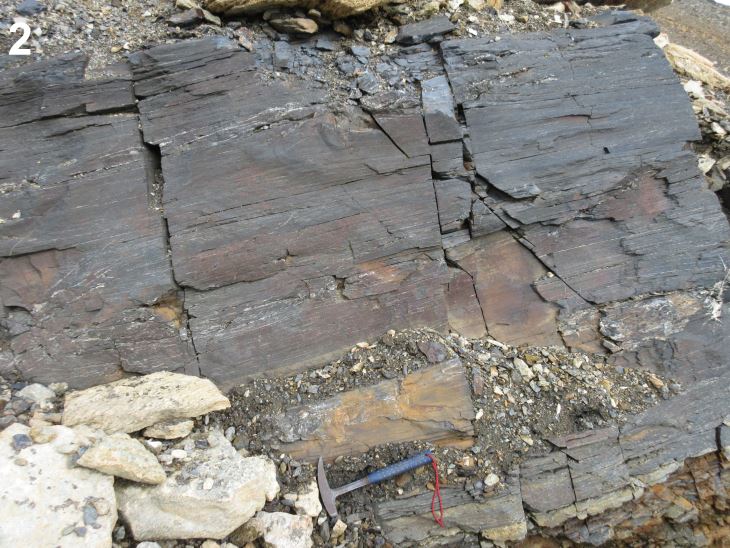
HURAI, Vratislav – HURAIOVÁ, Monika – HABLER, Gerlinde – HORSCHINEGG, Monika – MILOVSKÝ, Rastislav – MILOVSKÁ, Stanislava – HAIN, Miroslav – ABART, Rainer**. Carbonatite-melilitite-phosphate immiscible melts from the aragonite stability field entrained from the mantle by a Pliocene basalt. In Mineralogy and Petrology, 2023, vol. 117, p. 467-496. (2022: 1.8 – IF, Q3 – JCR, 0.628 – SJR, Q2 – SJR). ISSN 0930-0708. https://doi.org/10.1007/s00710-022-00783-1
This work deals with inclusions in a plagioclase megacryst from basalt diatreme in the Hajnáčka village of southern Slovakia, where infiltration of complex carbonatite-silicate-phosphate melt was recorded. The melts crystallised at ~2 GPa pressure within aragonite stability field. Phosphate domains in fibrous calcite as well as exsolutions of phosphate melts consist of carbonate apatite with 7 wt. % CO2, in which CO32- group replaces PO43- and simultaneously HCO3– or CO32- substitute for OH– and halogens. Apatite with the formula Ca10-x(PO4)6-x(CO3)x(OH)2-2y(CO3)y(x»y ® 1) was described in nature for the first time, although it had been synthesized artificially at high CO2 pressure.

PÁNISOVÁ, Jaroslava – GRECO, Filippo** – CARBONE, Daniele – BRANCA, Stefano Felice – VAJDA, Peter. New insights into geological setting of the summit area of mount Etna volcano (Italy) inferred from 2D gravity data modelling. In Frontiers in Earth Science, 2023, vol. 11, no., article number 1171884. (2022: 2.9 – IF, Q2 – JCR, 0.88 – SJR, Q1 – SJR). ISSN 2296-6463. https://doi.org/10.3389/feart.2023.1171884
Sicilian stratovolcano Etna (Italy) due to its almost persistent mild explosive activity belongs to best monitored and studied volcanoes in the world. We have interpreted gravity data consisted of 31 measuring profile points from survey undertaken in 2015 using 2D density modelling. We have detected the presence of low-density material below the summit craters, down to the depth of about 2.1 km, interpreted as fumarolized and structurally weakened material. It is likely that the proximity of the conduits feeding the summit craters contributes to the gravity low in the SW half of the profile. Conversely, the gravity low observed at the northern edge of the profile could reflect the high concentration of faults and eruptive fissures in the Pizzi Deneri area (Ellittico caldera rim). This case study demonstrates how gravimetry can provide knowledge useful for understanding the processes occurring in the uppermost portion of the volcano edifice.
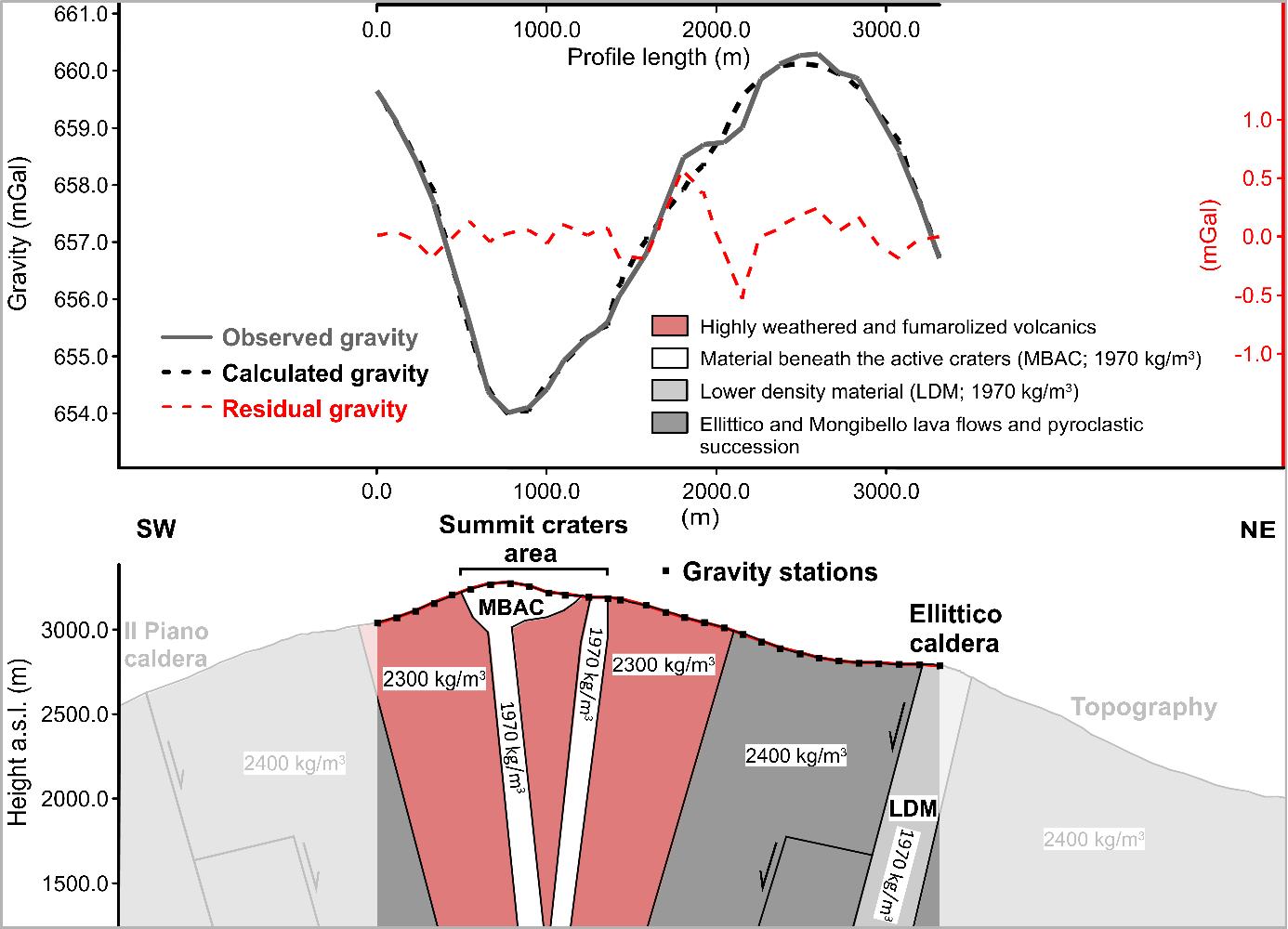
Monographs
ONDERKA, Milan – PECHO, Jozef. Národný klimatický program Slovenskej republiky. Zv. NKP 17/22. Návrhové hodnoty intenzít krátkodobých dažďov na Slovensku-Lokálne odhady. 1. vyd. Bratislava : Hydrometeorologický ústav, 2022. 500 s., 567 príloh (tb., gr.). ISBN 978-80-99929-39-6.
The National Climate Program of the Slovak Republic (Volume 17/22) represents an update of the work initiated in 1973 by Ferdinand Šamaj and Štefan Valovič. This monograph offers an in-depth investigation of short-term rainfall intensities in Slovakia. We draw upon the latest advancements in the field of statistical processing of hydrometeorological extremes. Local estimates of short-term rainfall frequencies (design values) are based on observations within the national monitoring network operated by the Slovak Hydrometeorological Institute, covering the period roughly from 1990 to 2021. Digitized pluviograph tapes and data from automatic rain gauges were processed and analyzed for 150 locations across Slovakia. Our aim was to publish updated version of local estimates of rainfall frequencies for durations ranging from 5 to 300 minutes. The publication also includes a relatively detailed description of the methodology used in estimating the parameters of the Generalized Extreme Value distribution using Bayesian inference. This book contains extensive material with of rainfall frequencies estimated for return periods 2 – 1000 years, presented in a concise tabular and graphical format. Uncertainties in the estimated short-term rainfall frequencies have not been consistently addressed in any research project in Slovakia to date. The design values of rainfall published in this monograph are presented together with uncertainties for the first time.
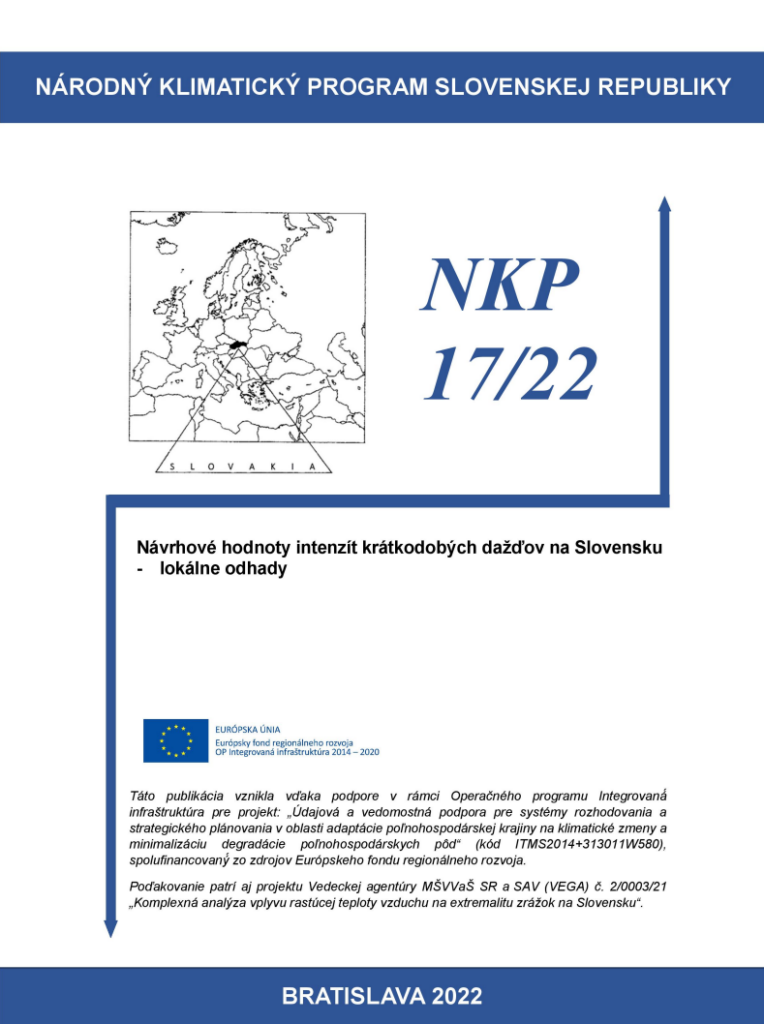
TOMAŠOVÝCH, Adam** – DOMINICI, S. – NAWROT, Rafał – ZUSCHIN, Martin. Temporal scales, sampling designs and age distributions in marine conservation palaeobiology. In Conservation Palaeobiology of Marine Ecosystems. 1. vyd. – London : The Geological Society, 2023, p. 1-39. ISBN 978-1-78620-577-3. ISSN 0305-8719.
Conservation palaeobiology is a new field of paleontological research that discriminates between original, undisturbed ecosystem states and states perturbed by human impacts and activities over the past decades, centuries and millennia, and thus informs conservation and restoration of ecosystems on the basis of their fossil record. In this paper, authors highlight two approaches that remedy the challenges associated with the mixing of pre-impact and post-impact states caused by sediment reworking and bioturbation. They show that combining surface death assemblages (preserved at the present-day seafloor) with both (1) fossil assemblages preserved in the subsurface stratigraphic record and (2) living assemblages collected alive can uniquely resolve the magnitude and timing of past ecosystem shifts. When the fossilization dynamic is accounted for, age distributions of benthic invertebrates from Holocene sediments often reveal prolonged shutdown in production or pervasive regime shifts that are obscured in the raw stratigraphic record.
